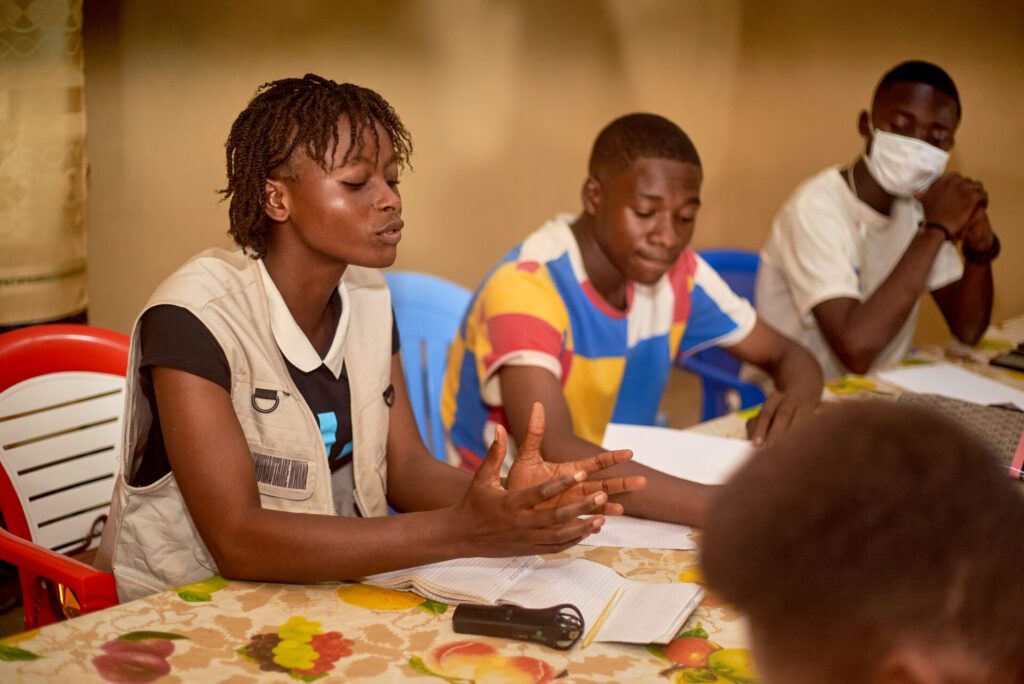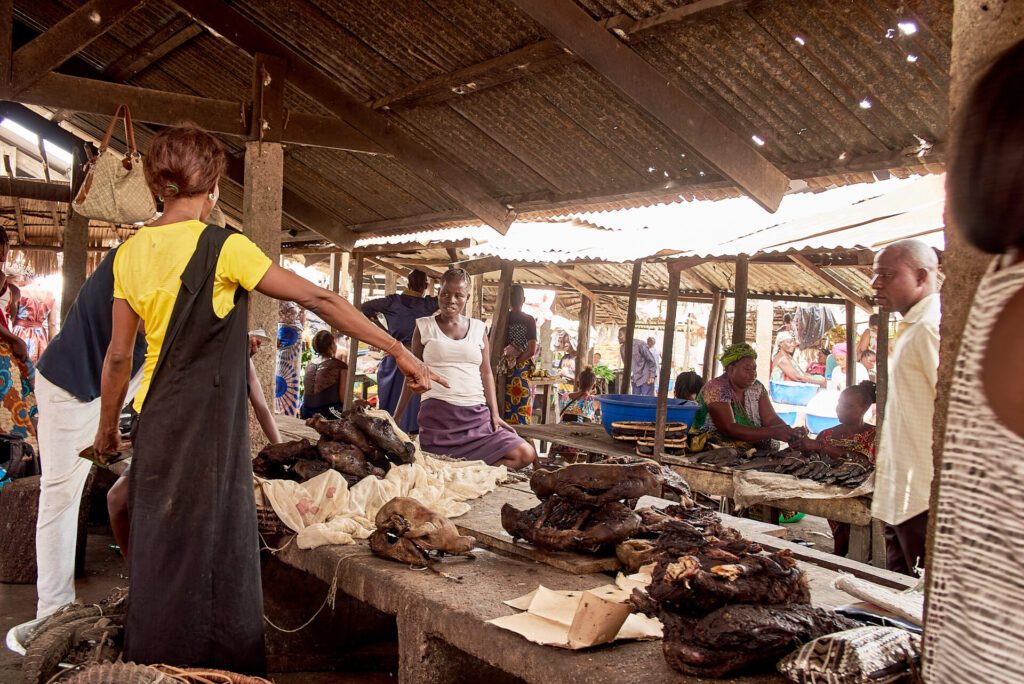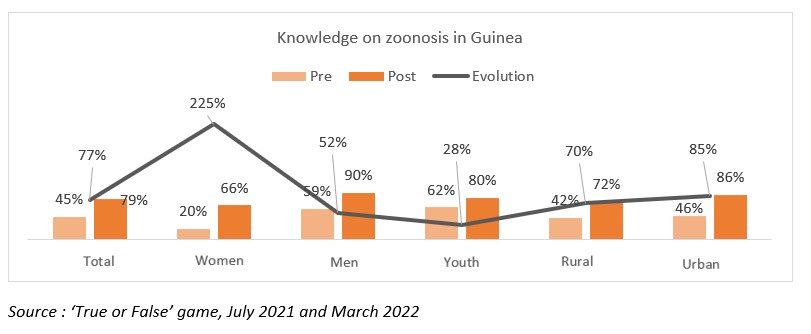WOAH raises community awareness on zoonosis through rural radio in Western and Central Africa

Twitter? Facebook? Television? We now live in the digital age, where many among us use screens and the internet to get our daily news. However, radio is still the most common source of news across the African continent. Where newspapers, internet, and television signal can fail to deliver, radio remains the most reliable form of media, especially for remote or isolated communities.
When sharing essential health information, this access to isolated populations can be life-saving. Certain life-threatening diseases like Ebola are zoonoses—those that pass from animals to humans, and vice versa— and can occur in forested areas where humans and animals have a shared environment. Places often lacking in a steady internet and television signal.
The World Organisation for Animal Health (WOAH)’s EBO-SURSY Project supports countries to improve their surveillance systems of zoonoses, and raise awareness on animal diseases among local populations of 10 countries in Western and Central Africa. The project focuses on viral hemorraghic fever diseases (including Ebola), with each country being endemic of one or more of these diseases.
Communication on health can be sensitive. For humans, we do not want to cause any unnecessary panic or stigmatisation in communities. And for animals, we do not wish that information on animal disease endangers them. In order to engage local communities thoughtfully, and to discuss the causes of animal to human spillover of viral hemorraghic fevers, WOAH partnered with the NGO, Children Radio Foundation (CRF). They are specialists in rural radio working directly with youth reporters and radio broadcasters to engage local communities in open, informative dialogues on the radio waves.
EBO-SURSY Project on the radio waves
Together, our intervention focused on five radio sites with wide coverage in forested areas or national parks in Guinea and the Democratic Republic of the Congo (DRC), places that were adversely affected during the 2014 Ebola epidemic, or more recent epidemics. In each of these five radio sites, we trained radio broadcasters and youth reporters, two groups who are passionate about engaging their communities, and were excited to broach a new topic, namely the interconnection of animal and human health. We supported them in delivering radio content in fun, engaging ways, deepening their knowledge on zoonosis, Ebola and the importance of wildlife, while offering insightful ideas for radio programming through our Production Guide for Zoonosis Awareness-Raising on Radio.

For example, the project trained broadcasters on developing PSAs, or Public Safety Announcements and vox-pops, where many people are asked the same question in a local place such as the market. Broadcasters were also introduced to new ideas for interviews of animal health professionals and environmentalists, audio portraits for those impacted by animal diseases, and commentary on the state of animal health in zoonosis in the community. The Guide provides some detailed examples to get the broadcaster started, such as this PSA:
[Footsteps on leaves. Bird calls.]
Voice 1: Hey Bob, look, another dead antelope.
Voice 2: This is the second time in a week that we have found it, it’s weird!
Voice 1: Really weird. Fortunately, we decided to not touch it, it may have been killed by a disease.
Voice 2: Fortunately, let’s not touch it and above all let’s alert the wildlife services right away.
Voice-over: A sick wild animal can be easy prey, but not a good meal! Do not hunt animals that look sick as they may carry viruses that cause diseases.
These types of messages invoke creative ways for local communities living in close contact with wildlife, at the animal-human interface, to make the connection between their behaviours and their health, as well as the link of animal and human health. Furthermore, it gives the community an action they can follow (call the wildlife services, or do not touch dead or sick animals), as well as the opportunity to play a part in the larger regional and national surveillance system of animal diseases. Only when local communities recognise signs of animal diseases in the nature around them, and alert the proper authorities, can we ensure a safer and healthier world, where preventative action, rather than response efforts after a large-scale outbreak, saves lives.

© World Organisation for Animal Health/Elijah Muwaza
Evaluating our impact on the community
Over the course of five months, radios in forested regions of Guinea and the DRC, broadcasted the EBO-SURSY Radio key messages on zoonosis, bushmeat, Ebola and other diseases, reaching over 700,800 people. During the post-evaluation of the programme, where we held focus groups investigating radio listening habits, behaviour change, and attitudes on zoonosis, we found that in Guinea, nearly 45% of people 18 and older knew of the EBO-SURSY Radio programme, and 70% of them followed it regularly. In the DRC, 39% of participants knew the radio programme, 54% of them followed it regularly.
Engaging the focal group participants in the Disease of Animal Origin true or false game both pre and post the radio programme illuminated the change of knowledge on zoonoses and infectious animal diseases in their communities. Guinea had the lower starting point for knowledge on the topic, and had the largest improvement by the end of the programme of 79%. Meanwhile, in the DRC, a country with more frequent outbreaks of Ebola, started off with a higher level of knowledge on zoonoses (51%), including Ebola, and still managed an overall growth of knowledge by 45%. With this increase of knowledge on zoonosis, the EBO-SURSY Project aims to increase engagement of local communities in recognising the signs of animal health outbreaks that could spillover into the human population, thereby preventing future disease outbreaks.
When community members were asked to reflect on the evolution of their knowledge level on zoonosis, 50 % of those who had followed the EBO-SURSY Radio programme responded that it had changed the attitudes of the community towards wildlife either ‘a lot’ or ‘enormously’. One listener to Radio Espace Foret in N’zérekoré, Guinea called the radio to share:
I sincerely appreciate the quality of the awareness messages on the radio. I think that if this had taken place before the first episode of Ebola, we would not have seen so many deaths. You will understand with me that today the communities have basic notions for the prevention of diseases. Thank you for the initiative and I hope it continues.
Radio Espace Foret listener in N’zérekoré, Guinea
While the EBO-SURSY Radio programme has ended after its five-month run, the project continues to disseminate the Production Guide for Zoonosis Awareness-Raising on Radio (available in French and English) to other countries in West and Central Africa who are impacted by viral hemorraghic fevers. The importance of zoonosis awareness cannot be understated, as a few weeks after the final EBO-SURSY messages hit the air, there was a new Ebola outbreak near our radio site in Mbandaka, DRC. The interconnection between animals and humans in these communities remains strong, and only through higher awareness and respect for the animals and environment with whom we cohabitate can we build a healthier future for all.
Other resources:
-
EBO SURSY Project website
-
Radio toolkit
-
2021 Activity report: Innovating for wildlife health


